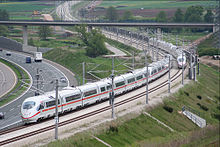Transition bend

The transition curve is a routing element that is used in the construction of traffic routes as a connection between a straight line and a circular arc or between two circular arcs. It is characterized by the fact that - in contrast to straight lines and arcs - it has a different radius of curvature at each point .
This has the effect that at the transition between a straight line and a circular arc, the curve becomes narrower only slowly and not suddenly. Figuratively speaking, using the example of a road, this means that the steering wheel does not have to be turned suddenly at one point, but is moved slowly from the middle position to the maximum deflection. The purpose of a transition curve is to continuously build up or reduce the centrifugal forces occurring in the curve when driving through and not jerkily.
For example, it is only through the use of transition arches that it has become possible to build roller coasters with loopings , which without transition arches would pose a risk to passengers.
Transition arcs that meet with the same radius are called apex arcs. Transitional arcs that connect circular arcs of different radii are known as egg lines .
The most commonly used transition arcs are the clothoids , the sinusoids, and the cubic parabola . The Deutsche Bahn also uses an S-shaped transition curve (transition curve according to Schramm) and the Blossbogen . This is a fourth (Schramm) or fifth order (Bloss) parabola. Since the transition curve according to Bloss has more favorable driving dynamics properties as well as a shorter development length, the S-shaped transition curve is no longer used for conversions and new buildings.
A new development is the Wiener Bogen , in which the center of gravity of a vehicle is also taken into account.
The offset (also called tangent offset ) is the distance between the straight line and the circle. It depends on the waveform chosen - two examples:
- (cubic parabola)
- (4th degree parabola)
This contains the length of the transition curve and the radius of the circular arc.
history
After sufficient experience with the training and arrangement of transition bends was available, the general requirement to arrange transition bends where necessary was included in the railway building and operating regulations of May 8, 1967. Previously, provisions on transition arches had been issued by the supervisory authority. In previous regulations ( BO , TV) in the 1920s it was planned to arrange a transition curve of at least 300 times the length of the superelevation at the maximum permissible speed. In Prussia, for reasons of comfort, it should not fall below 600 times if possible.
Individual evidence
- ^ Heinz Delvendahl: The railway systems in the new railway building and operating regulations (EBO) . In: The Federal Railroad . tape 41 , no. 13/14 , 1967, ISSN 0007-5876 , pp. 453-460 .
- ↑ Erich Giese , Otto Blum , Kurt Risch: Linienführung (= Robert Otzen [Hrsg.]: Reference library for civil engineers . Volume 2 , no. 2 ). Julius Springer , Berlin 1925, p. 213 f .





